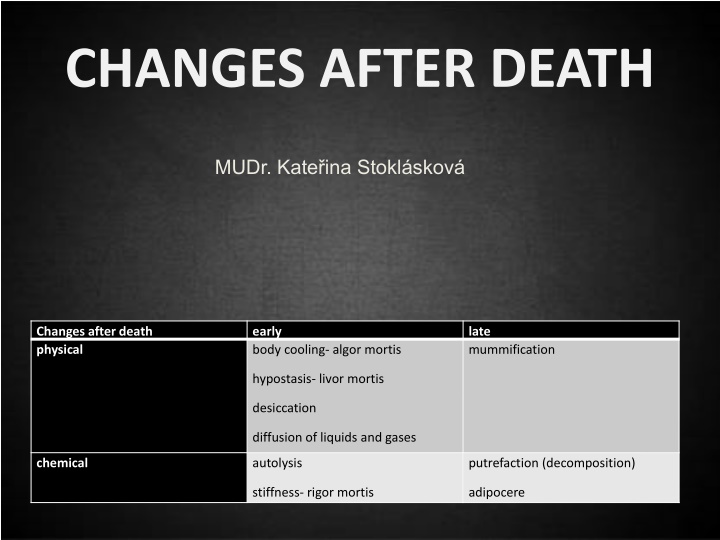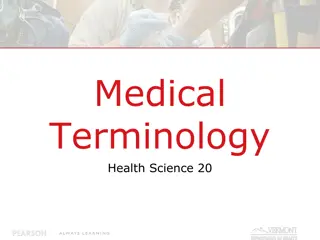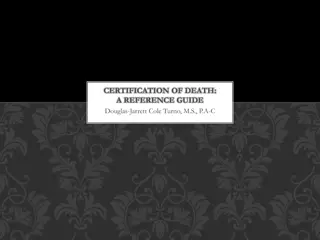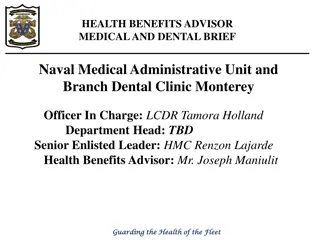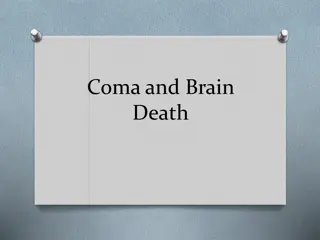Insights on Changes After Death and Definition of Death in Medical Science
Explore the physical changes that occur after death, such as body cooling, mummification, and putrefaction. Learn about the traditional and modern criteria for determining death, including somatic and brain death. Delve into the complexities of cellular death and the implications for organ transplantation. Discover the case of Terri Schiavo, highlighting the ethical debates surrounding end-of-life care.
Download Presentation

Please find below an Image/Link to download the presentation.
The content on the website is provided AS IS for your information and personal use only. It may not be sold, licensed, or shared on other websites without obtaining consent from the author.If you encounter any issues during the download, it is possible that the publisher has removed the file from their server.
You are allowed to download the files provided on this website for personal or commercial use, subject to the condition that they are used lawfully. All files are the property of their respective owners.
The content on the website is provided AS IS for your information and personal use only. It may not be sold, licensed, or shared on other websites without obtaining consent from the author.
E N D
Presentation Transcript
CHANGES AFTER DEATH MUDr. Kate ina Stokl skov Changes after death physical early body cooling- algor mortis late mummification hypostasis- livor mortis desiccation diffusion of liquids and gases chemical autolysis putrefaction (decomposition) stiffness- rigor mortis adipocere
Cessation of heartbeat and respiration traditionally, both the legal and medical communities determined death through the end of respiration and heartbeat but with the increasing ability of medicine to resuscitate patients, a need for better definition of death became obvious life support equipment can manintain body functions for a long time a demand for organ transplantation is rising
Patophysiology of death It is conventional to describe two types of death: Somatic death the person is unconscious, unable to be aware of the environment, to communicate, unable to initiate any voluntary movement reflex nervous activity may persist, circulatory and respiratory functions continue either spontaneously or with artificial support Cellular death cells no longer function and have no metabolic activity it is a process- not an event- different tissues die at different rates, the cerebral cortex being vulnerable to only few minutes anoxia, connective tissues surviving for many hours
Brain death equals somatic death the number of minutes for which total anoxia will cause cortical damage is estimated 8 minutes hypothermia (e.g. immersion under water) reduces the oxygen needs of the tissues even 40 minutes of hypoxia has been claimed as not leading to brain damage when the higher levels of cerebral activity are selectively lost (hypoxia, trauma, toxic insult), the victim will exist in vegetative state (coma vigile, apalic syndrome) the vicitim can remain in deep coma certainly for years, is able to sustain circulation and respiration, control body temperature, excerete waists, heal wounds, gestate featus
http://news.bbc.co.uk/onthisday/hi/dates/stories/november/19/newsid_2520000/2520581.stmhttp://news.bbc.co.uk/onthisday/hi/dates/stories/november/19/newsid_2520000/2520581.stm https://en.wikipedia.org/wiki/Terri_Schiavo_case
http://brno.idnes.cz/zena-porodila-v-komatu-0be-/brno- zpravy.aspx?c=A160209_164845_brno-zpravy_zde
Brainstem death it is another matter when the brain death spreads below the tentorium (midbrain, pons, upper medulla) the victim is not only irreversibly comatose, but also incapable of spontaneous breathing without medical intervention, hypoxic cardiac arrest inevitably follows within minutes and then the usual progression of cellular death ensues Diagnosis of brain death panagiography, cerebral blood flow and echo-doppler- can prove the death of higher brain , but not the brain stem irreversible brain stem dysfunction is diagnosed using ABR (auditory brain stem responses) and SEP (short latency somatosensory potentials) EEG- in the United States a flat EEG test is not required to certify death, it is considered to have confirmatory value. In the UK it is not considered to be of value.
deador not? vita minima- apparent death- hypnotics overdose, electricity injury, lightning strike, coma, drowning agony- vita reducta- the struggle that precedes death
Uncertain signs of death- paleness, no pulse, no blood pressure, areflexia Certain signs of death- livores mortis, rigor mortis, putrefaction,
Body Cooling Algor Mortis the rate of cooling is proportional to the difference in temperature between the body surface and its surroundings the ideal cooling curve would be exponential, but it is not in the real human body estimation of the time of death is complicated, there are many factors affecting cooling of the body: initial body temperature (fever, hypotermia, diurnal variation, physical activity, ) body size (obesity, children) body posture clothing and coverings ambient temperature air movement and humidity air x water
Body Cooling roughly the decrease in temperature is 1 C/hour, but without considering all the factors affecting cooling, this is highly inaccurate
Hypostasis hypostasis occurs when the circulation ceases and the gravity acts upon the stagnant blood and pulls it down to the lowest accessible areas bluish red discoloration begins as blotchy patches which soon coalesce, the color depending on the state of oxygenation at death darker tint is a result of reduced haemoglobin in skin vessels asphyxia pink or dark red in hypothermia cherry pink color of carboxyhaemoglobin in carbon monoxide poisoning pattern of hypostasis depends on the posture of the body after death pale areas are the result of pressure against a hard supporting surface hypostasis may start forming after 30 minutes, reaches maximum within 8-12 hours does not have much value for estimation of the time since death in some cases may not be visible at all (infants, old people, anaemia, bleeding out ), in some cases it can be observed in the living if the heart action is failing
Hypostasis Once hypostastis is established, it can undergo subsequent gravitational shift if the body is moved into a different posture, the primary hypostasis may either: move completely to the newly lowest areas can be examined by thumb pressure be partly relocated and partly fixed remain fixed due to staining of the tissues by haemolysis
Hypostasis blood also settles in the internal tissues and organs differentiation between hypostasis and bruising the classic test is to incise the suspect area to see if the underlying blood is intravascular (hypostasis) or infiltrating the tissues outside the vessels (contusion), histological examination may be necessary
Desiccation caused by evaporation of fluids from the body s naturally wet regions (eyes, lips, genitals) or wounds Autolysis cellular lysozomes disintegrate and hydrolases are released, which break down cells and cellular membranes starts in pancreas, stomach mucosa Diffusion of liquids and gases result of autolysis natural barriers do not function anymore and liquids and gases spread freely though the tissues
Rigor mortis immediately after death there is general muscular flaccidity, usually followed by a period of partial or total rigidity, which in turn passes off as the signs of decomposition appear rigor is initiated when the ATP concentration falls to 85 % of normal stiffness may start developing within 30 minutes or may be postponed almost indefinitely (physical activity before death, electrocution X freezing) reaches maximum within 6-12 hours duration of full rigor may be 18-36 hours rigor is first apparent in the smaller muscle groups jaw, facial muscles, neck fades in the same order of muscle groups as it appeared rigor can be broken during manipulation with the body rigor mortis in other tissues iris, heart, dartos muscle, seminal vesicles, prostate, erector pili muscles poorly developed ininfants, elderly, cachectic cadaveric spasm a rare form of virtually instantaneous rigor that develops at the time of death with no period of post-mortem flaccidity (soldiers, falling from height)
A rough estimation of the post-mortem interval in average condition (18C): the body is: warm and flaccid less than 3 hours warm and stiff 3-8 hours cold and stiff 8-36 hours cold and flaccid more than 36 hours
cremation death putrefaction mummification adipocere skeletization complete dissolution (unless fossilized)
Putrefaction (decomposition) onset depends on the environment, but in average conditions the putrefaction starts after approximately 3 days first external naked-eye sign is discoloration of the lower abdominal wall (caecum) 1 week the color of the skin is green/ black/ reddish putrefactive bacteria spread through the venous system, hemolyze the blood and stain the vessels and adjacent tissues greenish-black the face and other soft tissues become swolen and pervaded by fluid and gas 2-3 weeks skin blisters appear, filled with clear, pink or red fluid later the skin starts peeling off, the hair and nails detach the scrotum and breasts are swolen bloody fluid (tissue liquefaction stained by haemolysis) leaks from body orifices several months soft tissues disintegrate, leaving ligamentous and tendineous tissues attached to skeleton
Forensic Enthomology animal, especially insect infestation depends on the ambient temperature and environment
Decomposition in immersed bodies the rate of decomposition is slower- approximately twice compared to decopmosition in air water slows down putrefaction mainly because of the lower ambient temperature and protection from insect the epidermis becomes macerated and eventually detached gas formation is the reason for flotation of an unweighted body the usual posture of a freely floating body is face down
Decomposition in buried bodies the rate of decay of bodies buried in earth is much slower than those in either air (approximately eight times) or water- due to lower temperature, exclusion of animal and insect predators and lack of oxygen after 10 years only bones should be found in the grave unless
Adipocere the body tissues transform into a waxy substance derived from the body fat caused by hydrolysis and hydrogenation of adipose tissue by anaerobic bacteria (fatty acids + K, Na, Ca, Mg ions) the tissues are greasy or waxy, later brittle and chalky, white, pinkish, greenish or grey requires MOISTURE (usually wet soil or water), usually warmth and alcalic pH adipocere starts forming after approximately 3 months
Mummification dried out body, usually only some body parts (fingers, toes, ears, nose) the skin is dry, hard, brown secondary colonization by moulds causes white, green or black patches on the skin can only occur in a DRY environment, preferably with moving air current, which is usually also warm mummification can take weeks or months, depending on the environment
Damage caused by animals after death there is no bleeding, oedema or reddening of the edges of the wound, no other vital signs of injuries
